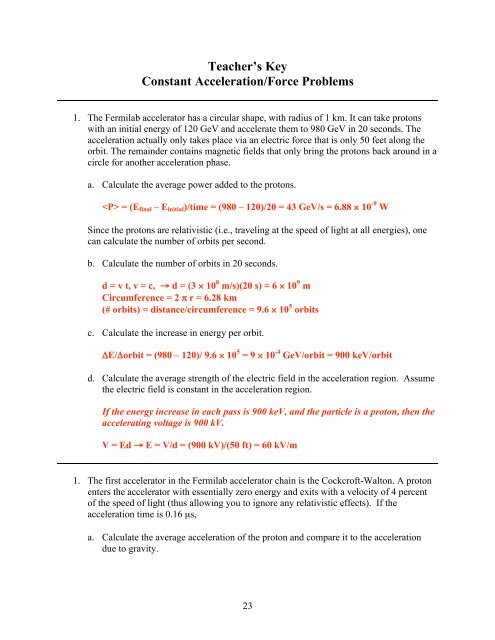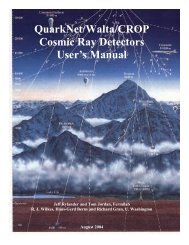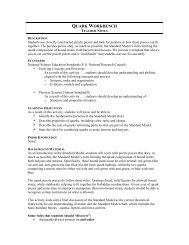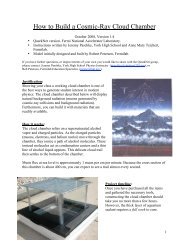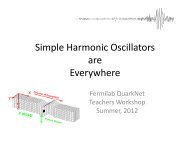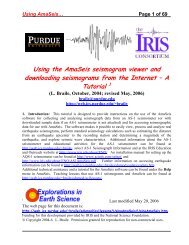Teaching Modern Physics - QuarkNet - Fermilab
Teaching Modern Physics - QuarkNet - Fermilab
Teaching Modern Physics - QuarkNet - Fermilab
You also want an ePaper? Increase the reach of your titles
YUMPU automatically turns print PDFs into web optimized ePapers that Google loves.
Teacher’s Key<br />
Constant Acceleration/Force Problems<br />
1. The <strong>Fermilab</strong> accelerator has a circular shape, with radius of 1 km. It can take protons<br />
with an initial energy of 120 GeV and accelerate them to 980 GeV in 20 seconds. The<br />
acceleration actually only takes place via an electric force that is only 50 feet along the<br />
orbit. The remainder contains magnetic fields that only bring the protons back around in a<br />
circle for another acceleration phase.<br />
a. Calculate the average power added to the protons.<br />
= (Efinal – Einitial)/time = (980 – 120)/20 = 43 GeV/s = 6.88 × 10 -9 W<br />
Since the protons are relativistic (i.e., traveling at the speed of light at all energies), one<br />
can calculate the number of orbits per second.<br />
b. Calculate the number of orbits in 20 seconds.<br />
d = v t, v = c, → d = (3 × 10 8 m/s)(20 s) = 6 × 10 9 m<br />
Circumference = 2 π r = 6.28 km<br />
(# orbits) = distance/circumference = 9.6 × 10 5 orbits<br />
c. Calculate the increase in energy per orbit.<br />
ΔE/Δorbit = (980 – 120)/ 9.6 × 10 5 = 9 × 10 -4 GeV/orbit = 900 keV/orbit<br />
d. Calculate the average strength of the electric field in the acceleration region. Assume<br />
the electric field is constant in the acceleration region.<br />
If the energy increase in each pass is 900 keV, and the particle is a proton, then the<br />
accelerating voltage is 900 kV.<br />
V = Ed → E = V/d = (900 kV)/(50 ft) = 60 kV/m<br />
1. The first accelerator in the <strong>Fermilab</strong> accelerator chain is the Cockcroft-Walton. A proton<br />
enters the accelerator with essentially zero energy and exits with a velocity of 4 percent<br />
of the speed of light (thus allowing you to ignore any relativistic effects). If the<br />
acceleration time is 0.16 µs,<br />
a. Calculate the average acceleration of the proton and compare it to the acceleration<br />
due to gravity.<br />
23


